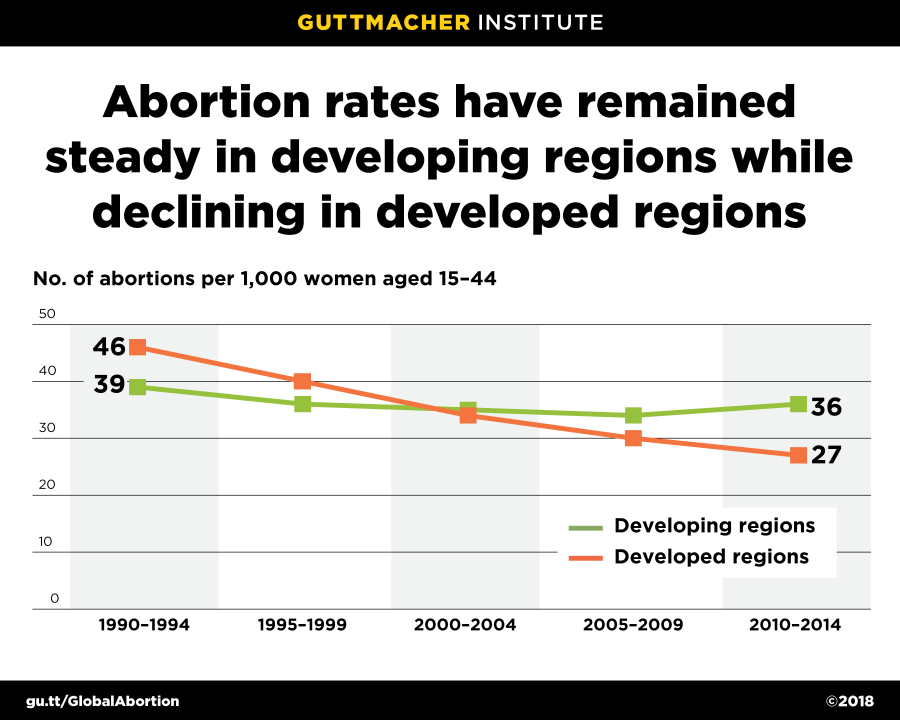A comprehensive new report released today by the Guttmacher Institute highlights ongoing disparities in abortion rates and in access to safe abortion services in developing and developed regions. The report, Abortion Worldwide 2017: Uneven Progress and Unequal Access, pulls together the latest research on abortion incidence, safety and legality, as well as on unintended pregnancy. Globally, rates of abortion have declined over the past 25 years. In addition, evidence in the report demonstrates that procedures have become safer in many parts of the world.
Although the worldwide annual abortion rate fell between 1990–1994 and 2010–2014, most of this change occurred in developed regions (from 46 to 27 abortions per 1,000 women of reproductive age); the abortion rate in developing regions hardly changed (from 39 to 36 per 1,000 women). During this same period, the global unintended pregnancy rate declined, from 74 unintended pregnancies per 1,000 women of reproductive age in 1990–1994 to 62 per 1,000 women in 2010–2014. Unlike abortion rates, unintended pregnancy rates declined substantially in both developed and developing regions.
"Improved contraceptive use, and in turn, declines in unintended pregnancy rates are the likely driver behind the worldwide decline in abortion rates," says Susheela Singh, Vice President for International Research at the Guttmacher Institute. "Most women who have an abortion do so because they did not intend to become pregnant in the first place. Meeting the need for contraception is critical to bringing down rates even further."
Abortion rates vary widely among world regions. Latin America and the Caribbean has the highest annual rate of abortion of any world region, 44 per 1,000 women of reproductive age, compared with 36 in Asia, 34 in Africa, 29 in Europe, and 17 in Northern America (all per 1,000 women). Latin America and the Caribbean is also the region with the highest unintended pregnancy rate—96 per 1,000 women of reproductive age. Despite Asia’s far lower rate of unintended pregnancy (54 per 1,000 women), the sheer size of its population means that nearly 54 million unintended pregnancies occur every year in that region; of these, nearly two-thirds (65%) end in abortion.
Notably, abortion rates are similar in countries where abortion is highly restricted and where it is broadly legal: The abortion rate is 37 per 1,000 women in countries where abortion is prohibited or permitted only to save the life of the pregnant woman, and 34 per 1,000 women in countries where abortion is not restricted as to reason. Legal restrictions do not eliminate abortion. Rather, they increase the likelihood that abortions will be done unsafely, as they compel women to seek clandestine procedures. Indeed, abortion tends to be safer in countries where it is broadly legal and in countries with a high gross national income.
Abortion safety is now defined with greater nuance than in the past because of women’s increasing access to safer methods in clandestine settings. Abortion is considered safe when a WHO-recommended method is used by a trained person, less safe when only one of these conditions is met, and least safe when neither is met. Together, less-safe and least-safe abortions make up all unsafe abortions. Of the 56 million induced abortions that occurred annually between 2010 and 2014, 55% were safe, 31% were less safe and 14% were least safe.
The safety of abortions has improved because of advances in clinical guidelines and broadening legality in a number of countries. In addition, where abortion laws are highly restrictive, the increased use of misoprostol (a widely available and affordable drug that induces abortion effectively) has also improved safety. Even when used by an untrained person, misoprostol is still safer than traditional methods of clandestine abortion that are considered the least safe, such as inserting sharp objects into the uterus or ingesting toxic substances.
"Improvements to abortion laws, service provision guidelines and practices in a number of countries have made abortion safer worldwide; however, millions of women living in countries where abortion is highly restricted continue to experience the negative consequences of unsafe abortion," says Sneha Barot, Senior Policy Manager at the Guttmacher Institute and author of a policy analysis based on the report.
Major obstacles to eliminating unsafe abortion and its consequences remain. As of 2014, at least 22,800 women still die each year worldwide from complications of unsafe abortion. This is partly because stigma leads many women—even in countries where abortion is legal—to seek clandestine abortions, which are more likely than other abortions to be unsafe. Stigma also causes women to delay seeking treatment for complications from unsafe procedures. Moreover, high unmet need for modern contraception in many countries results in high rates of unintended pregnancy, and restrictive laws limit or prohibit the availability of safe abortion services. Finally, regardless of abortion legality, poor and rural women in low-income countries are less likely than wealthy and urban women to be able to access safe abortion services because of cost and location.
Much work needs to be done to improve access to safe abortion care, and to reduce unsafe abortion and its toll on women’s health. Governments, donors, advocates and health providers must undertake multiple strategies to achieve these goals. The authors recommend that policymakers loosen legal restrictions on abortion and implement policies that expand access to abortion-related services. This includes training a wider range of health personnel to provide comprehensive abortion and postabortion care. Since unintended pregnancy is the main reason for abortions, health officials and providers must ensure that women have access to high-quality contraceptive services to prevent unintended pregnancies in the first place. Given the high costs of unsafe abortion—in terms of health and the financial burden on poor women and developing countries’ budgets—reducing unsafe abortion is critical to ensuring the well-being of women, their families and their countries.
For more information, read the full report:
Abortion Worldwide 2017: Uneven Progress and Unequal Access by Susheela Singh, Lisa Remez, Gilda Sedgh, Lorraine Kwok and Tsuyoshi Onda
